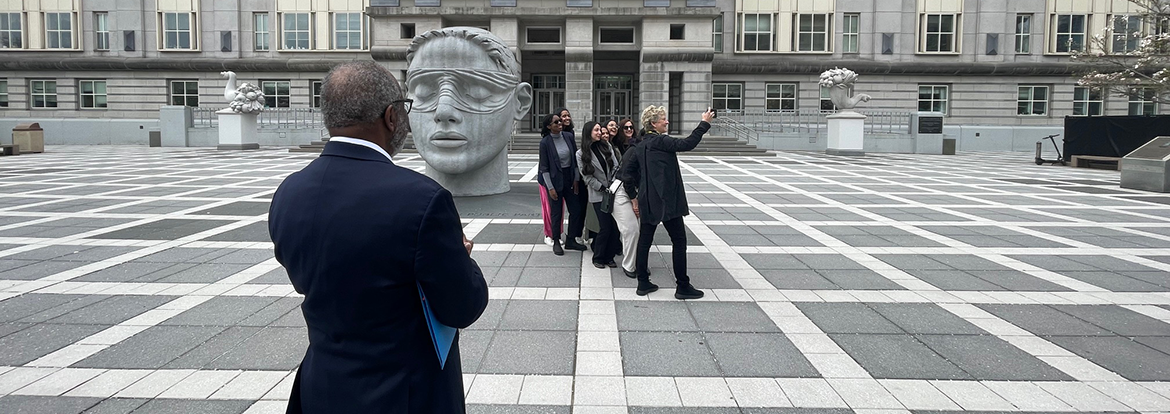
Students partner with GSA to bring green to urban space
Some folks might think of Newark as a typical New Jersey city: industrial, gritty, a place where tractor trailers rumble off the exits of the turnpike. A place where federal dollars might not be going toward grass, trees, or earth.
Things changed when GSA officials partnered with a group of urban design and architecture students from the New Jersey Institute of Technology. Together, they have redesigned the space surrounding the Peter A. Rodino Federal Building. Potholed streets will be replaced by better paving, trees, grass and places for people to rest while doing business with their government.
“It was pretty car heavy. There were a lot of parking spaces. It was unclear where we could walk and where we couldn’t,” said Anuradha Kadam, one of the former NJIT students who is now a sustainability consultant with an engineering firm in New York City. Kadam was part of the cohort of students whose classwork delivered an acclaimed 3D-printed model that shows what the plaza could look like if it had funding. “When we went on site, there weren’t many places to really sit and rest or take photos.”
The 3D model of the improvements – on track to become a reality through a new Inflation Reduction Act investment – shows what students call the “green spine,” or greenway incorporated into the middle of the restoration.
“We were looking to make the street more pedestrian friendly in the federal campus,” said then-student Ebony Payne, now a designer and project manager at a firm in Brooklyn, New York. “We were looking at ways to incorporate bike lanes and open it up to pedestrians, to revitalize the plaza and make it a place where people could gather.”
The Rodino site – named for the Newark-born congressman who served 40 years in the U.S. House of Representatives – has seen an increase in public use, because of long lines and large crowds during naturalization ceremonies, said Frank Giblin, the director of GSA’s Center for Community Planning + Design, which oversees the agency’s Good Neighbor Program.
The Good Neighbor Program aims to harmonize federal spaces with local community needs to foster sustainable urban development. Including the Newark federal campus, the program recently received $24 million in Inflation Reduction Act funding for 13 projects at federal buildings across 10 states. GSA Administrator Robin Carnahan announced the program’s funding boost at the Newark site last month where she met with some of the NJIT students.
The students were part of a studio that was assigned to redesign the block of urban space around the federal building. Some were interested in urban design, some in architecture, some in sustainable materials, and all were keen to restore the street in front of Rodino into a plaza where people could stop and enjoy, including those in the surrounding neighborhood.
“I analyzed different activities, such as people taking celebratory pictures after their naturalization ceremonies and people waiting in line for appointments they had,” said Samantha Garcia, an architectural designer in Princeton, New Jersey, who mentioned that her own family emigrated from Colombia. “I chose that building thinking about them and trying to make a more welcoming space that I would want them to go to.”
Like Garcia, many members of the studio had personal experiences at that federal building and experienced it as a user of that neighborhood, Giblin said on a recent episode of the GSA Does That!? podcast.
“They attacked the project with such rigor that it really created a lot of energy on the GSA side,” Giblin said. “And now the project is addressing pretty much all three blocks of that campus.”
As a result of the collaboration and the funding, GSA will redirect stormwater runoff that now pools, and combat city heat by providing tree cover, greenspace and native plantings. (Notably, the nearby Martin Luther King Jr. Courthouse is also slated to receive $3.9 million in IRA funding for low-embodied carbon glass [PDF - 154 KB] – which contributes less greenhouse gas to the planet – to replace its windows later this year.)
The restoration of the site will improve neighborhood access to the plaza, as well as better connect it to the restaurants and shops in the surrounding neighborhood.
The students served a critical role of evaluating how the spaces are used and how they could be used better around the Newark site.
“We provided the different perspectives of users and stakeholders who would benefit from revitalization. We figured out what their needs were,” explained Kadam.
“This investment in the Rodino Federal Building campus — and Inflation Reduction Act funding for infrastructure projects throughout New Jersey — will bolster clean energy, create good-paying jobs, and strengthen our communities to better withstand the effects of climate change,” said U.S. Sen. Cory Booker, who has lived in Newark since 1998 and served as the city’s mayor before being elected to the U.S. Senate in 2013.
“This sustained collaboration was at the heart of the studio process, and was the foundation for its success,” said NJIT Professor Georgeen Theodore, who assembled the studio. “From my perspective, GSA has set a new gold standard for this type of work.”

 U.S. General Services Administration
U.S. General Services Administration
